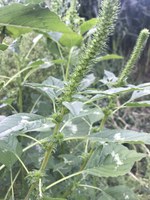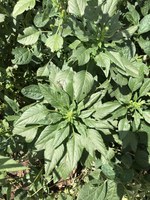NDSU Extension Offers Palmer Amaranth Control Options
(Click an image below to view a high-resolution image that can be downloaded)
Now that Palmer amaranth, a very aggressive weed, has been found in North Dakota, producers are looking for ways to prevent it from spreading.
Most of the Palmer amaranth plants that were found so far have produced very little seed, according to Brian Jenks, weed scientist at North Dakota State University’s North Central Research Extension Center near Minot. It was found in North Dakota for the first time this summer.
“It is possible that these plants germinated and emerged later than most weed seeds,” he says.
Many of the Palmer amaranth plants that were found had seed heads growing just above the tops of soybeans.
“Ideally, these weeds should be pulled and removed from the field,” Jenks says. “However, we may not see every Palmer plant. Although a preharvest burn-down in soybeans is not common, it may stop or reduce seed production of plants that were missed.
“If there were Palmer plants in the harvested field, the remaining stems still may regrow and produce seed if there is a delayed killing frost,” he adds. “Thus, a postharvest desiccation may be warranted to ensure zero seed production.”
Palmer amaranth is known to be resistant to the herbicide glyphosate in other states, so the plants found in North Dakota probably are glyphosate-resistant, too. Thus, glyphosate likely will not be effective as a Palmer amaranth desiccant (drying agent).
Jenks says the burn-down solution Gramoxone may be less effective against Palmer amaranth because the rate for soybean desiccation (dryness) is only 8 to 16 fluid ounces, which is lower than for other crops. Sharpen usually is more effective as a desiccant when tank-mixed with glyphosate, but given that the Palmer amaranth plants found in North Dakota likely are resistant to glyphosate, Jenks does not recommend this mix.
“A better option may be to tank-mix Gramoxone and Sharpen,” he says.
Here are some preharvest desiccant options:
- Gramoxone - 8 to 16 fluid ounces. Apply with NIS (nonionic surfactants). This has a 15-day preharvest interval (wait time between the application and when the crop can be harvested).
- Sharpen - 1 to 2 fluid ounces. Apply with AMS (ammonium sulfate) plus MSO (methylated seed oil). This has a three-day preharvest interval.
- Gramoxone (16 fluid ounces) plus Sharpen (2 fluid ounces) plus AMS plus MSO. This probably is the best option, Jenks says.
Here are recommendations for postharvest desiccant options:
- Gramoxone - 2 pints. Apply with NIS.
- Sharpen - 1 to 2 fluid ounces. Apply with AMS plus MSO.
- Gramoxone plus Sharpen plus AMS plus MSO
- Gramoxone plus 2,4-D plus NIS
Jenks suggests producers apply these chemicals at a spray volume of 20 gallons per acre to obtain adequate coverage.
“These herbicides work best under warm, sunny conditions,” he notes. “Forecasted highs in the coming days are for temperatures only in the 50s and 60s, with possible light rain. Desiccants will not dry down plants as fast under cool, moist conditions.”
He also cautions producers not to use Roundup or Sharpen preharvest on soybeans grown for seed.
NDSU Agriculture Communication - Sept. 25, 2018
| Source: | Brian Jenks, 701-857-7677, brian.jenks@ndsu.edu |
|---|---|
| Editor: | Ellen Crawford, 701-231-5391, ellen.crawford@ndsu.edu |



